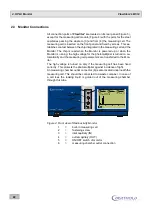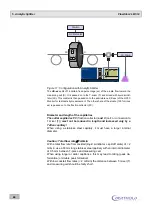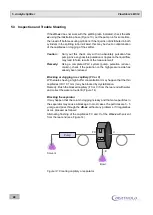
3. Measuring Cells
FlowStar2 LB 514
34
Excessive incidence of light into the measuring chamber has to be avoided,
as otherwise the noise rate of the photomultiplier will increase and drop to
the normal level only after several hours. If direct sun light and direct light
from fluorescent lamps is avoided, and the chamber is not open for an un-
necessarily long time, the instrument will be ready for measurement after
just a few minutes.
GT-solid scintillator cells and the Gamma measuring cell, e.g.
J-1000
and
BGO-X
, should also be stored in a dark room and not be exposed to light
during assembly in order to reduce phosphorescence. The decay time of
photomultipliers and GT cells is dependent on the amount of light it has
been exposed to: the more light the photomultipliers or GT cells have
“seen”, the longer the decay period.
3.3 Connecting Steel Capillaries
Only stainless steel capillaries should be connected to the measuring cell
for supply (IN) and disposal (OUT) of the eluate or the eluate cocktail to
prevent incidence of light.
Teflon or other plastic capillaries, e.g. PEEK capillaries, do not ensure any
light-sealed operation!
When using Teflon capillaries, a 10 - 15 cm long steel capillary piece
should be used before each cell in- and outlet; shape it in the form of a
spiral or a wave to suppress any light guide effect.
The outlet capillary must always have a larger inner diameter
than the
inlet capillary!
(see Figure 7)
Outlet capillary in solid cell: min. ID
0.5 mm
Outlet capillary in admixture cell: min. ID
1.0 mm
The following capillaries are supplied with each instrument:
1 m steel capillary OD 1/16"
ID
0.5 mm (for supply and disposal)
1 m steel capillary OD 1/16"
ID
1.0 mm (for disposal)
Please check the capillaries every time you connect new capillaries!
Before connecting a capillary, please check and see that the bore-hole of
the steel capillaries is open and the connection sleeves of the measuring
cell are clean.
When cutting the length of the steel capillaries, never pinch them off, but
always use a capillary cutter, or break the capillary after slightly scratching
it by means of a capillary cutter or a feather-edge file!
If the outlet capillary has to be extended, please make sure that no low
dead-volume capillary unions will be used. These unions have only a very
small bore-hole which leads to a rise in backpressure which may destroy
the cell.
















































